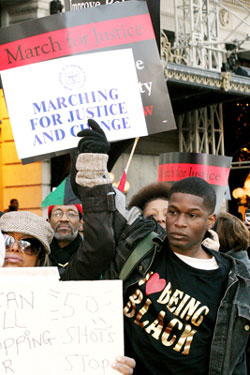

 |
|
Militant/Robin Mace
|
| 10,000 people, in their majority Black, march on Manhattan’s Fifth Ave. December 16 to protest cop brutality. |
Benefield, who was shot three times, led the march from his wheelchair, along with Nicole Paultre, Bell's fiancée who was supposed to marry the young African-American worker the day he was killed.
Abner Louima, a Haitian immigrant brutally beaten and sodomized by New York City cops in 1997; Rev. Alfred Sharpton, a Democratic Party politician; and Congressman Charles Rangel also walked at the front of the procession.
The march stretched five lanes wide over 10 city blocks. It included contingents from the United Federation of Teachers, American Postal Workers Union, and Service Employees International Union locals 1199 and 32BJ. Other contingents came from Hunter College and City College, churches, and community organizations. Participants were in their overwhelming majority Black, many of them workers and young people participating in their first political protest.
Hours after the march ended, a cop shot and killed Anatoly Dmitriev, 62, a Russian immigrant, in the Bronx. Dmitriev was the second person killed by New York City police since Bell. The first, 19-year-old Timur Person, was shot five times at close range in the chest when cops wrestled him to the ground in an apartment building lobby December 13.
The police department has defended both killings, claiming that the victims were armed in each case. Dmitriev, who neighbors and relatives describe as mentally unstable, was descending a fire escape holding an ax when a cop shot him twice in the chest. Police spokesman Paul Browne called the killing "within department guidelines."
Cops recovered a .38-caliber gun on Person after killing him. They claimed Person had pulled the gun on the cops, but witnesses contradict the police account.
"At no time did he grab the gun," said Hector Suárez, a witness. "Right when he was on the floor, they shot him."
Bell, Benefield, and Guzman were unarmed when five cops opened fire on them as they left Bell's bachelor party. The cops claimed a "fourth man" present at the scene was armed. But eyewitnesses have contradicted that claim and other elements of the cops' story, as have a preliminary police report and police dispatch records from the night of the shooting.
While Queens district attorney Richard Brown has yet to set any timetable for an investigation into Bell's death, police raids on working-class neighborhoods throughout the city have continued under the guise of searching for the "fourth man."
Terry McKenzie and Gerald Williams were picked up in a raid on the housing project where they and Benefield live. "They kept asking me about shootings," McKenzie told NY1 News. "I didn't cooperate with them, so that's when they took me downstairs to be charged." The cops claim they found crack cocaine on McKenzie, but he insists drugs never came up during the interrogation.
"They kneed me in the stomach and then hit him in his neck," said Williams.
Like McKenzie and Williams, many at the December 16 march had their own stories of police harassment to tell. Marcher Anthony Faison, for example, served 15 years in jail for a crime of which he was later exonerated.
“If there was a fourth man he would have been shot too," said Kenisha Wakefield. "It is an excuse for a murder, to cover it up.”
"It could be any Black man, my brother or my father," said marcher Kashana Ames. "Shoot first, ask questions later—that’s their motto." Handmade signs featured slogans like, "It could have been me," or "NYPD: please don't kill my husband, my nephew, my son." One marcher wore a T-shirt stating, "I am Sean Bell."
Thirteen people have been killed by cops in New York City this year. Police have killed an average of 12 people a year since 2002, down from about 25 a year during the 1990s.
“They’re the biggest gang in New York. You’re really guilty until proven innocent," said Waliike El, a member of the American Postal Workers Union, in an interview during the march.
"I've had cops pull a gun on me three times, and the only thing I ever did wrong was run a red light," said Steven Palmore, a teacher who also works installing carpets. "There's no way I'm not going to be out here. If they locked me up I'd break out just to be here."
As this issue goes to press, another 100 people marched in Jamaica, Queens, near the site of the November 26 shooting to demand justice for Sean Bell.
Related articles:
Letters
Front page (for this issue) |
Home |
Text-version home